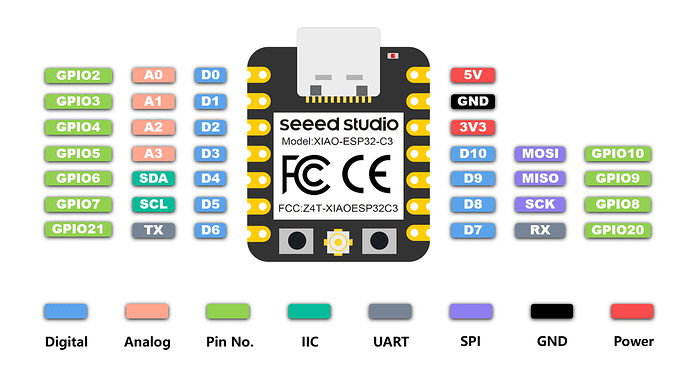I’ve managed to use this beautifull board with my Seeed XIAO RP2040.
Still looking for correct I2C Touch device name (appears to be CST816S with I2C address of 0x2E, but I am not sure yet).
The library for touch device could be installed using
circup install adafruit_cst8xx
Using todbot examples at: GitHub - todbot/CircuitPython_GC9A01_demos: Demos showing how to use CircuitPython displayio driver for GC9A01 round LCDs and change the pinout and new displayio method (for Circuitpython 9.x):
import time, math, random
import board, busio
import displayio
import adafruit_imageload
import gc9a01
# This need to be changed
tft_dc = board.D3
tft_cs = board.D1
tft_bl = board.D6
# The touch int pin. Not used here...
touch_int = board.D7
spi = busio.SPI(clock=board.SCK, MOSI=board.MOSI)
# load our eye and iris bitmaps
dw, dh = 240,240 # display dimensions
eyeball_bitmap, eyeball_pal = adafruit_imageload.load("imgs/eye0_ball2.bmp")
iris_bitmap, iris_pal = adafruit_imageload.load("imgs/eye0_iris0.bmp")
iris_pal.make_transparent(0)
# compute or declare some useful info about the eyes
iris_w, iris_h = iris_bitmap.width, iris_bitmap.height # iris is normally 110x110
iris_cx, iris_cy = dw//2 - iris_w//2, dh//2 - iris_h//2
r = 25 # allowable deviation from center for iris
# class to help us track eye info (not needed for this use exactly, but I find it interesting)
class Eye:
def __init__(self, spi, dc, cs, rot=0, eye_speed=0.3, twitch=2):
display_bus = displayio.FourWire(spi, command=dc, chip_select=cs)
display = gc9a01.GC9A01(display_bus, width=dw, height=dh, rotation=rot)
main = displayio.Group()
# This is the new way to show something in display
display.root_group = main
self.display = display
self.eyeball = displayio.TileGrid(eyeball_bitmap, pixel_shader=eyeball_pal)
self.iris = displayio.TileGrid(iris_bitmap, pixel_shader=iris_pal, x=iris_cx,y=iris_cy)
main.append(self.eyeball)
main.append(self.iris)
self.x, self.y = iris_cx, iris_cy
self.tx, self.ty = self.x, self.y
self.next_time = time.monotonic()
self.eye_speed = eye_speed
self.twitch = twitch
def update(self):
self.x = self.x * (1-self.eye_speed) + self.tx * self.eye_speed # "easing"
self.y = self.y * (1-self.eye_speed) + self.ty * self.eye_speed
self.iris.x = int( self.x )
self.iris.y = int( self.y )
if time.monotonic() > self.next_time:
t = random.uniform(0.25,self.twitch)
self.next_time = time.monotonic() + t
self.tx = iris_cx + random.uniform(-r,r)
self.ty = iris_cy + random.uniform(-r,r)
self.display.refresh()
# a list of all the eyes, in this case, only one
the_eyes = [
Eye( spi, tft_dc, tft_cs, rot=0),
]
while True:
for eye in the_eyes:
eye.update()
